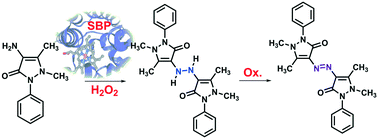Biocatalytic oligomerization of azoles; experimental and computational studies†
Abstract
Azoles are an important class of small molecules in pharmaceuticals and in pesticides which are found in surface water and effluents of wastewater treatment plants. With increasing research on novel characteristics of such compounds, they are considered emerging contaminants, thus, the efficiency of existing technologies for their treatment becomes an important matter. Peroxidases have proven to be effective in transformation of phenols and anilines via radical coupling. Here, the feasibility of oxidative polymerization of selected azoles with soybean peroxidase is demonstrated. The sensitivity of such treatment to the most important parameters, pH, enzyme activity and peroxide concentration, was investigated. Enzymatic treatment was shown to be effective with ≥70% transformation efficiency in all cases, with hydroxybenzotriazole having the highest efficiency among the substrates tested, thus providing a baseline for future study of real wastewater and environmental samples. Radical-coupling products after treatment were shown by mass spectrometry to be dimers and trimers and structures are proposed based on regiochemistry predicted from radical spin-density computations. Ionization energy and reduction potential of the compounds studied were also computed to look for a correlation with enzyme reactivity.



 Please wait while we load your content...
Please wait while we load your content...